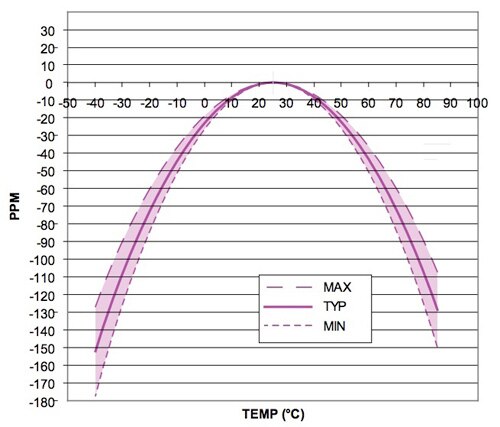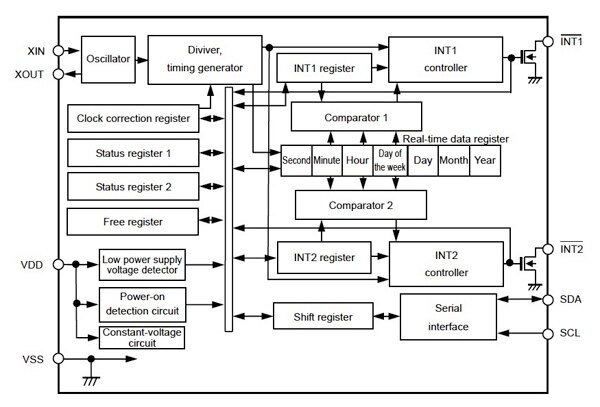Low-Power Devices Ensure Accuracy in Ambient Energy Applications
投稿人:电子产品
2014-04-16
Using energy-harvesting methods, wireless sensor systems can provide data on physical phenomena for years or even decades without battery replacement. At the same time, sensor data acquisition requires careful recording of time and date using a real-time clock (RTC). Dedicated RTC ICs provide the combination of functionality and ultra-low-power operation required for sensor systems powered by ambient energy. In building accurate ambient-powered sensor systems, engineers can choose from low-power RTC ICs from manufacturers including Cymbet, EPSON, NXP Semiconductors, Seiko Instruments, and STMicroelectronics, among others.
Accurate measurement of temperature, pressure and physical phenomena depends on reliable real-time recording of event timing. Accurate timestamp data places each piece of sensor data in the context required to understand if the data represents a trend or intermittent spike in the physical environment.
Designers can take advantage of RTC functionality implemented in software algorithms or in hardware integrated in MCUs or provided in standalone RTC ICs. Although designers can implement RTC functionality in software running on MCUs, most MCUs intended for embedded applications include integrated RTC functionality.
For applications with tight power budgets, however, using an MCU for RTC function can require significant power consumption. Advanced embedded MCUs typically consume on the order of 1 μA even in their lowest-power sleep modes with RTC or timer running. As described below, available RTC ICs operate at a fraction of this power level, providing distinct advantages for ambient-powered sensor applications with relatively slow update rates.
RTC ICs
In energy-harvesting applications with very limited power budgets, hardware RTC ICs can provide reliable time measurement at power levels well below that of implementations using an MCU's hardware RTC functionality. In their simplest form, RTCs provide the current time and date, including year, month, and day of the week. Typically, advanced RTCs provide additional features, including programmable timers, countdown alarms, interrupt output, and square wave output that can be used elsewhere in an application circuit. Implementing RTC functionality in a design typically requires simple connections with the device's serial output and oscillator input pins (Figure 1).

Figure 1: RTC ICs typically provide a simple hardware interface, including output lines, for the I²C or SPI interface, as well as timer, fault, and clock output. Input lines include those for an external crystal oscillator, although some devices integrate the crystal as well (Courtesy of STMicroelectronics).
Typically, RTC ICs are designed to use an oscillator frequency of 32.768 kHz, exactly 215 cycles per second, simplifying use with binary counter circuits. Although these devices typically use an external crystal oscillator, engineers can find RTC devices built with an integrated crystal oscillator that further reduce the footprint for space-constrained applications. STMicroelectronics offers its M41T62 in a single package that combines an RTC die and matched oscillator crystal. At 3.2 x 1.5 mm, the LCC package is about the same size as the smallest crystal-only devices. Operating at supply voltages ranging from 1.3 to 4.4 V, the M41T62 draws only 350 nA and features an I²C serial interface.
For tight power budgets, engineers can find available devices such as the NXP PCF2123 and PCF8523 optimized for low power consumption. The PCF2123 operates with a typical current as low as 100 nA and provides an SPI serial interface operating at a maximum data rate of 6.25 Mbps. The PCF8523 requires only slightly more power at 150 nA and typically provides an I²C-bus serial interface running at a maximum data rate of 1 Mbps.
The Epson RX8571 requires only 220 nA at 3 V and operates across a wide supply range of 1.6 to 5.5 V with time-keeping operations available down to 1.3 V. As with many devices in this class, the Epson device integrates a small 128-bit user RAM. The device offers a built-in frequency-adjusted 32.768 kHz crystal unit and provides a 32.768 kHz frequency output through a CMOS output with control pin.
Temperature variation
The relatively low-cost crystals used as timing sources for RTC ICs have a typical accuracy within about ±25 ppm or about 2 seconds per day at 25°C. Crystals exhibit a characteristic parabolic curve for temperature dependency with errors as great as -177 ppm at the limits of a typical industrial range of -40° to +85°C (Figure 2). At this degree of variation, the time loss can exceed 10 seconds/day.

Figure 2: Frequency error follows a characteristic parabolic curve for typical 32.768 crystals. At the extremes, this error can result in time loss in excess of 10 s/day (Courtesy of STMicroelectronics).
Designers can enhance accuracy through careful crystal screening, use of more expensive AT cut crystals, or use of temperature-compensated crystal oscillators (TCXO). TCXOs integrate a temperature sensor and compensation-control logic that flattens a crystal's parabolic temperature curve over a wide temperature range. In many applications, the added cost of these methods is prohibitive, particularly in applications where the highest possible accuracy is not required.
In fact, designers can implement a variety of custom temperature compensation methods that monitor the output of a temperature sensor and adjust the RTC ICs clocking frequency accordingly. To support this approach, some RTC ICs provide features that allow designers to advance or delay the clock to meet the desired effective clock frequency despite temperature-dependent variation in oscillator frequency.
For example, the Seiko Instruments S-35390A includes a clock adjustment function that enables wide-ranging correction of deviation in the frequency of the crystal oscillator at a minimum resolution of 1 ppm. A one-byte register in the device provides a clock adjustment value that can be set to respond to changes in the crystal's temperature (Figure 3).

Figure 3: Designers can find RTC ICs, such as the Seiko Instruments S-35390A, that provide a clock-correction register for adjusting effective clock frequency to accommodate temperature-dependent variation in crystal frequency (Courtesy of Seiko Instruments).
The S-35390A is a low-current-consumption, two-wire, CMOS real-time clock IC that features a wide-operating-voltage range (1.3 to 5.5 V) and can be driven on a variety of supply voltages, from a main supply to a backup supply. The time-keeping current consumption of 0.25 µA and minimum-time-keeping-operation voltage of 1.1 V enable greatly increased battery duration.
Backup power
RTC functionality depends on the ability to maintain operations required to update the current date and time, as well as timers, alarms, and other features. Consequently, applications such as energy harvesting with uncertain power sources typically require backup power provided by supercapacitors or thin-film energy storage devices.
RTC ICs such as the STMicroelectronics M41T83 feature a built-in power sense circuit that switches to a backup power source when it detects a failure in the primary source. As with ST's M41T62, the M41T83 is available with an integrated crystal oscillator. Requiring as little as 365 nA, the M41T83 features seven bytes available as user SRAM and provides an I²C serial interface. The M41T93 provides similar features with an SPI bus-compatible serial interface.
Cymbet provides an integrated solution to backup power with its EnerChip CBC34803 (I²C interface) and CBC34813 (SPI) RTC devices. Both devices integrate an RTC with an EnerChip thin-film storage device in a 5 x 5 x 1.4 mm 16-pin package able to provide up to 120 hours of power backup.
Conclusion
Real-time clocks serve a critical role in providing the accurate time and date information required in nearly every embedded application. In sensor designs powered by energy harvesting, ultra-low-power RTC ICs deliver time and date data at power levels well below that available through alternate solutions. Using available devices, engineers can implement accurate RTC functionality with little burden to tight power budgets.
For more information on the parts discussed in this article, use the links provided to access product information pages on the Digi-Key website.
免责声明:各个作者和/或论坛参与者在本网站发表的观点、看法和意见不代表 DigiKey 的观点、看法和意见,也不代表 DigiKey 官方政策。







 中国
中国